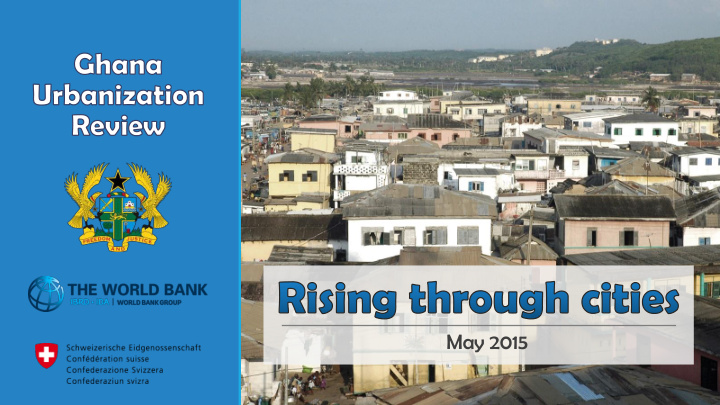



May 2015
2
SOURCE: UN WORLD URBANIZATION PROSPECTS, 2014 80% 70% % Urban 60% Today 50% 40% 30% 20% 10% GHANA’S SUCCESSFUL URBANIZATION 0% 1980 1985 1990 1995 2000 2005 2010 2015 2020 2025 2030 2035 2040 2045 2050 3
Full range of GDP per capita % Urban Share GDP per capita, USD thousands c onstant int’l Geary -Khamis SOURCE: MADDISON 2006; UNITED NATIONS 1969, 1949, 1953, 2006C; HISTORICAL DATABASE OF THE GLOBAL ENVIRONMENT 4
Strong relationship between income and urbanization 100 Urbanization 90 rate, % 80 70 60 50 40 All countries, 2013 30 20 Ghana, 1990-2013 10 Log. (All countries, 2013) 0 6 7 8 9 10 11 12 Log GDP per capita, PPP (constant 2011 US$) 5 SOURCES: WDI; WORLD BANK STAFF CALCULATIONS.
% Poverty incidence in selected regional areas 80 1991 70 73 2012/13 60 62 50 55 53 40 38 30 30 28 28 26 26 20 23 10 10 10 0 ACCRA URBAN URBAN URBAN RURAL RURAL RURAL (GAMA) COASTAL FOREST SAVANNAH COASTAL FOREST SAVANNAH SOURCE: GSS 2013, 2014. 6
Secondary education attainment of population 15+ years % 40 2000 2010 30 32 32 30 28 25 25 20 18 17 15 14 14 14 10 12 11 7 6 0 ACCRA KUMASI SEKONDI/TAKORADI TAMALE TEMA CLASS 6 CLASS 7 OTHERS 7 SOURCE: GUR I, ANNEX TABLE 14
SOURCE: UN WORLD URBANIZATION PROSPECTS, 2014 80% 70% Today 60% 50% 40% 30% 20% CHALLENGES IN FURTHER ENHANCING ECONOMIC GROWTH 10% AND INCLUSION THROUGH CITIES 0% 1980 1985 1990 1995 2000 2005 2010 2015 2020 2025 2030 2035 2040 2045 2050 8
GHANA’S URBAN POPULATION 9
ADDING ANOTHER LIBERIA! 10
DOUBLE IN JUST TWENTY YEARS! 11
12
14 1985 Manufacturing value added 12 10 (% of GDP) 8 2013 6 4 2 Urbanization rate (%) 0 30 35 40 45 50 55 13 SOURCES: WDI; WORLD BANK STAFF CALCULATIONS.
Sources of Ghana’s growth % Capital accumulation Human capital accumulation 8 Labor reallocation Total factor productivity 6 4 2 0 -2 1992-2006 2006-2010 SOURCES: WDI; WORLD BANK STAFF CALCULATIONS. 14
Share of employment – metropolitan areas Accra Kumasi Sekondi/Takoradi Tamale Tema 33.7 WHOLESALE 38.7 27.2 & RETAIL 30.4 28.6 13.3 13.4 MANUFACTURING 17.5 12.9 18 0 10 20 30 40 50 SOURCE: GHANA UR 15
Urban Footprint of West African Cities 1,400 1990 2002 2012 1,200 Area in 1148 sq kms 1,000 800 600 563 400 200 286 276 258 237 227 196 157 158 110 95 0 Abidjan Accra Conarky Cotonou SOURCE: WORLD BANK, THE FUTURE OF WATER IN AFRICAN CITIES: WHY WASTE WATER (2013) 16
Urban Density Population per Km 2 circa 1990 circa 2000 Circa 2014 20000 15000 15368 10000 11155 9842 7037 6961 5000 5651 5273 4209 2947 2460 1804 0 0 ABIDJAN ACCRA COTONOU CONARKY 17
Means of transport to and from workplace, 2007 foot trotro shared taxi 39.3 KUMASI 22.6 24.7 32.8 ACCRA 41.6 5.8 0 20 40 60 80 100 Percent of total Source: National Transport Survey 2007. 18
Change in access to piped water + toilet, 2000-10 Safe toilet facilities Piped water % ACCRA KUMASI SEKONDI/TAKORADI TAMALE TEMA CLASS 6 CLASS 7 OTHERS 20 10 10.9 10.1 9.3 1.7 0 -3.7 -3.8 -1.5 -0.5 -5.7 -7.3 -7.7 -8 -10 -11.1 -16.5 -20.3 -20 -22.2 -30 SOURCE: GUR I ANNEX TABLES. 19
Monthly income USD$638 15% of pop 15% of pop Monthly income required for cheapest complete house USD$970 80% 25% of pop 50% of pop Pop in slums 53% Pop in slums 60% of pop 35% of pop GHANA ADDIS ABABA SOURCES: UN-HABITAT GHANA HOUSING SECTOR PROFILE 2011 AFFORDABLE HOUSING INSTITUTE ETHIOPIA COUNTRY CASE STUDY 2014 20
Infrastructure Available financing at MMDA financing gap remains marginal Pc today 21 Source: Ghana UR
Policy priorities 22
EFFICIENCY EFFICIENCY EFFICIENCY EFFICIENCY Enables workers, firms, Enables new business Enables Enables materials to locate at dev and construction development of coordination and most efficient location: and agglomeration connective financing agglomeration effects economies infrastructure INCLUSION INCLUSION INCLUSION INCLUSION Improves service Supports the Strengthens Improves access delivery and capacity for provision of basic to affordable coordination in distribution of basic urban services housing service provision urban services 23
24
25
26
27
28
Recommend
More recommend